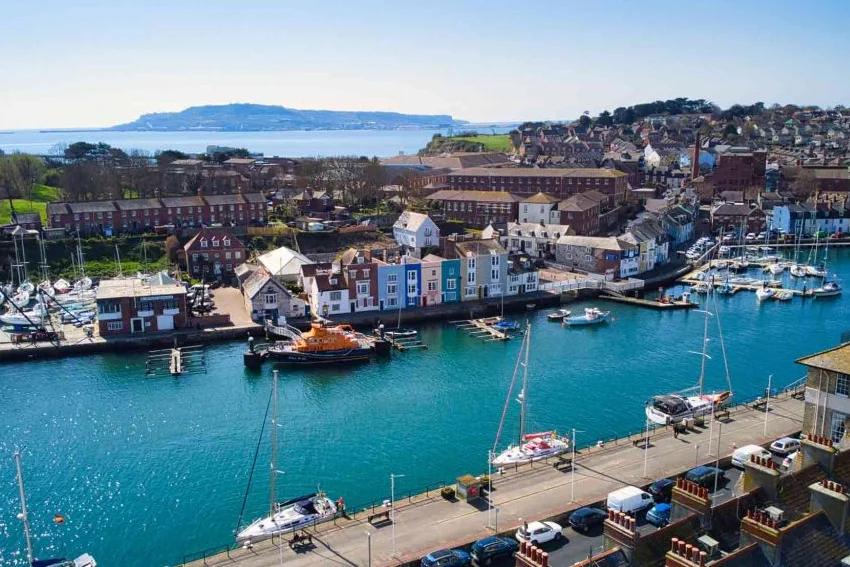RSPB Radipole Lake Nature Reserve
Radipole Lake is one of the RSPB’s most urban reserves and is a quiet ‘natural’ oasis right in the heart of Weymouth.
Over time it has been invaded by the Romans, harvested for thatch, had its own swan herder, been the site of a funfair and had a miniature railway. Protected by the local council in the 1930’s, it has been managed by the RSPB since 1976.
It is a great place to get up close to wildlife and the Wild Weymouth Discovery Centre has plenty for families to do, pond dipping, nature trails, competitions and events.
There are two walks:
• A circular route around the discovery loop
• and a longer route that goes to the viewing screen where you may see marsh harriers and sand martins.
For more information please visit the RSPB website.
Information
Distance: Circular Walk 1.6km 1.0miles.
Gradient: Flat level ground but the paths can get muddy in winter.
Starting Point: The RSPB Discovery Centre in the Swannery car park.
Public Transport: The main line train station is 400 metres away. Buses arrive at the King’s statue.
Parking: Car Park at the Swannery car park - a Dorset council owned Pay and Display car park. DT4 7TY.
Accessibility: Easy - Firm flat paths. There are plenty of seats for a rest as you go round. Mobility scooters can also be used, but the paths often flood in January.
Facilities
Café: Radipole Lake Discovery centre.
Toilets: Radipole Lake Discovery centre.
Discovery Centre to:
• Check what wildlife has been seen recently.
• See videos of wildlife taken at the reserve.
• Ask about activities and guided walks.
• Refresh yourself before setting off.
• You can hire binoculars if you don’t have any.
![]() Point 1
Point 1
From the Discovery Centre turn left, onto the bridge where you can feed the ducks and swans.
The Southern Railway used to promote trips to Weymouth as a place to feed the swans, thousands of people still do. See if you can identify the different birds on the water (don’t worry, there are some signs to help you). (N.B we have suspended selling duck food while Avian Flu is still an issue, ask in the centre for the latest advice).
As you walk up the path check out the view. Radipole Lake is surrounded by roads and a retail park, yet the reeds and water are still heaving with wildlife. By the time you reach the first platform, on your right, you should’ve seen plenty of small birds darting in and out of the reeds and bushes. Listen out for the explosive sound of Cetti’s warbler in spring and the pinging call of bearded tits.
Go up on the first platform and have a look over the reedbed. It can be difficult to get a sense of scale, walking through a flat landscape. Look up the reserve (the opposite way to where you have come from). Radipole Lake extends all the way to the blocks of flats to the north! You may see some fish in the ditches below, what animals might eat them?
![]() Point 2
Point 2
From the first platform carry on up the path and take the right-hand fork.
Look out for a path on your right to get a view over the body of water on the eastern edge of the reserve – check for great crested grebes and in summer look for dragonflies.. Further along on the left you’ll be able to take a small detour into the reeds on a boardwalk.
Turn left off the boardwalk and walk up to the picnic area. Take a break. Eat some food, have a drink, relax listening to birdsong, work out what each seat represents (they ae all animals that can be found on the reserve) – whatever you do here make sure you give the otter’s nose a rub before you leave.
From the seating area turn right and walk along to the viewing shelter.
There’s a great view over the water and into the reeds. Otters have been seen here, and you may also see a kingfisher and the great crested grebes.
From the double platform, known as the swan crossing carry along the path until you come to a junction. The swans are often on the path here so dogs should be on a lead.
![]() Point 3
Point 3
For the shorter circular walk, turn left and follow this path all the way back to the Discovery Centre. Before you go make sure you:
- Go pond dipping and discover what creatures lurk in the deep – from March to October (roughly!).
- Tell a member of staff or volunteer what you have seen.
- Check what else is happening around Weymouth and Portland and get some suggestions of where to explore next.
But for the longer walk turn right towards the concrete bridge
RSPB Longer Walk at Radipole Lake
Radipole Lake is one of the RSPB’s most urban reserves and is a quiet ‘natural’ oasis right in the heart of Weymouth. Over time it has been invaded by the Romans, harvested for thatch, had its own swan herder, been the site of a funfair and had a miniature railway! Protected by the local council in the 1930’s, it has been managed by the RSPB since 1976.
It is a great place to get up close to wildlife. The Wild Weymouth Discovery Centre has plenty for families to do, pond dipping, nature trails, competitions and events.
For more information please visit the RSPB website.
Information
Distance: Longer Walk 3km.
Gradient: Flat level ground but the paths can get muddy in winter.
Starting Point: The RSPB Discovery Centre in the Swannery car park.
Public Transport: The main line train station is 400 metres away. Buses arrive at the King’s statue.
Parking: Car Park at the Swannery car park - a Dorset council owned Pay and Display car park. DT4 7TY.
Accessibility: Easy - Firm flat paths. There are plenty of seats for a rest as you go round. Mobility scooters can also be used, but the paths often flood in January.
Facilities
Café: Radipole Lake Discovery centre.
Toilets: Radipole Lake Discovery centre.
Discovery Centre to:
• Check what wildlife has been seen recently.
• See videos of wildlife taken at the reserve.
• Ask about activities and guided walks.
• Refresh yourself before setting off.
• You can hire binoculars if you don’t have any.
![]() Point 1
Point 1
From the Discovery Centre turn left, onto the bridge and feed the ducks and swans. The Southern Railway used to promote trips to Weymouth as a place to feed the swans, thousands of people still do.
See if you can identify the different birds on the water (don’t worry, there are some signs to help you). (N.B we have suspended selling duck food while Avian Flu is still an issue, ask in the centre for the latest advice).
As you walk up the path check out the view. Radipole Lake, is surrounded by roads and a retail park, yet the reeds and water are still heaving with wildlife. By the time you reach the first platform, on your right, you should’ve seen plenty of small birds darting in and out of the reeds and bushes. Listen out for the explosive sound of Cetti’s warbler in spring and the pinging call if bearded tits.
Go up on the first platform and have a look over the reedbed.
It can be difficult to get a sense of scale, walking through a flat landscape. Look up the reserve (the opposite way to where you have come from). Radipole Lake extends all the way to the blocks of flats to the north! You may see some fish in the ditches below, what animals might eat them?
![]() Point 2
Point 2
From the first platform carry on up the path and take the right-hand fork.
Look out for a path on your right to get a view over the body of water on the eastern edge of the reserve – check for great crested grebes and in summer look for dragonflies..
Further along on the left you’ll be able to take a small detour into the reeds on a boardwalk. Turn left off the boardwalk and walk up to the picnic area.
Take a break. Eat some food, have a drink, relax listening to birdsong, work out what each seat represents (they ae all animals that can be found on the reserve) – whatever you do here make sure you give the otter’s nose a rub before you leave.
From the seating area turn right and walk along to the viewing shelter.
There’s a great view over the water and into the reeds. Otters have been seen here, and you may also see a kingfisher and the great crested grebes.
From the double platform, known as the swan crossing carry along the path until you come to a junction. The swans are often on the path here so dogs should be on a lead.
![]() Point 3
Point 3
For the shorter circular walk, turn left and follow this path all the way back to the Discovery Centre.
Before you go make sure you:
Go pond dipping and discover what creatures lurk in the deep – from March to October (roughly!).
Tell a member of staff or volunteer what you have seen. Check what else is happening around Weymouth and Portland and get some suggestions of where to explore next. But for the longer walk turn right towards the concrete bridge.
![]() Point 4
Point 4
This is another good place to see the ducks and swans close up (they will expect to be fed) and you may be lucky enough to see bearded reedlings here.
The path turns right parallel to the road and cycle path. (The cycle path will take you to Tumbledown Farm, Chafey’s Lake and Southill).
On your left look out for orchids in the summer. In spring you’ll see both blackthorn and hawthorn in flower. They are easy to tell apart, blackthorn flowers before the first leaves appear, with hawthorn the leaves come first.
![]() Point 5
Point 5
The path bears right and brings you to a wooden bridge with handrails where you cross the river Wey.
This is a good place to look out for water voles and as you continue the path between the river and the reedbed you will see dragonflies and butterflies in the summer.
![]() Point 6
Point 6
At the corner by the gate follow the path right, up to the north screen.
At the north screen, take a break on one of the benches and use the time to look for marsh harriers flying across the reeds, or sand martins flying in and out of the colony.
You will find QR codes to help you. When you’ve rested and seen everything there is to see, retrace your steps back to the Discovery Centre.
When you get back to the concrete Bridge it is quicker to carry straight on, rather than going back round the loop again. But either path will take you back to the start.




